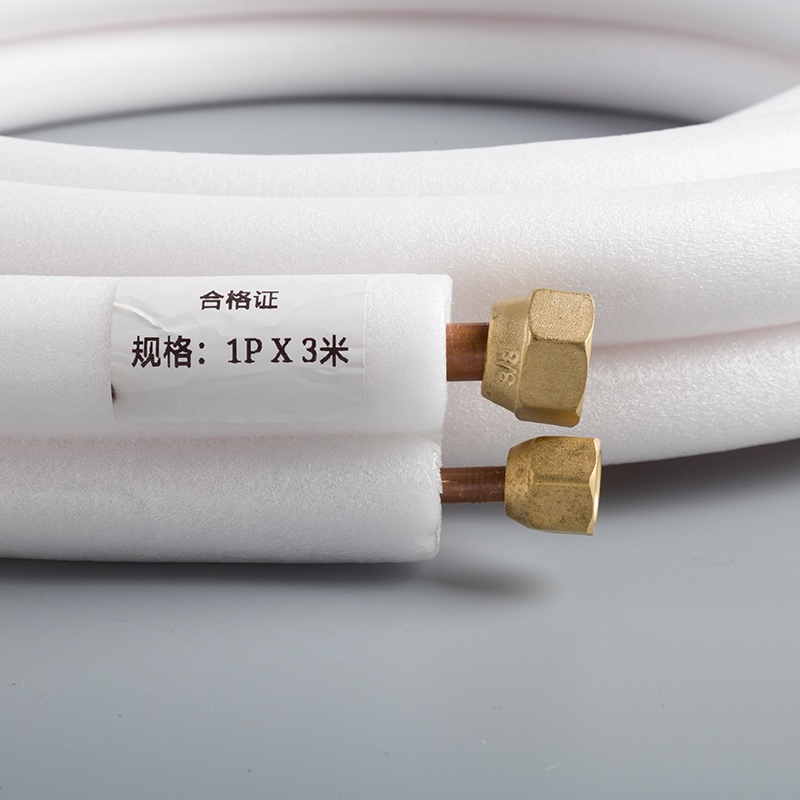Comparing Different Types of Copper Pipes for Air Conditioning

Selecting the appropriate copper pipes for air conditioning is a critical decision impacting system efficiency and longevity. Understanding the nuances of various copper pipe types is essential for optimal performance. This Comparison blog post on Different Types of Air Conditioning Copper Pipes provides a concise overview of Type K, Type L, Type M, and ACR copper pipes, delving into their unique characteristics, applications in air conditioning, and respective pros and cons. By examining key factors such as durability, cost, installation ease, and performance implications, readers will gain valuable insights to make informed decisions.
Types of Copper Pipes

Type K Copper Pipes
Characteristics
Type K Copper Pipes are recognized for their robust construction, boasting the highest pressure tolerance among common copper pipe types. Their strength and resilience make them ideal for main water lines and underground installations.
Applications in Air Conditioning
In air conditioning systems, Type K Copper Pipes excel in ensuring reliable connections between outdoor and indoor units. Their durability and high-pressure rating contribute to efficient cooling performance, crucial for optimal system operation.
Pros and Cons
Pros:
Exceptional strength for industrial settings.
Longevity due to robust construction.
Cons:
Higher cost compared to other copper pipe types.
Limited flexibility in installation due to thickness.
Type L Copper Pipes
Characteristics
Type L Copper Pipes strike a balance between affordability and durability, offering a reliable option for residential applications requiring efficient water distribution systems.
Applications in Air Conditioning
When utilized in air conditioning setups, Type L Copper Pipes provide secure connections essential for maintaining system integrity. Their higher pressure ratings compared to Type M pipes ensure consistent performance.
Pros and Cons
Pros:
Durable construction suitable for long-term use.
Enhanced pressure tolerance for various applications.
Cons:
Moderate initial cost may be a consideration.
Thickness can impact flexibility during installation.
Type M Copper Pipes
Characteristics
Typically more budget-friendly than Type L and Type K pipes, Type M Copper Pipes are well-suited for light domestic water lines where cost efficiency is paramount.
Applications in Air Conditioning
In air conditioning scenarios, Type M Copper Pipes offer a cost-effective solution without compromising on quality connections between components. They are ideal for low-pressure applications like domestic water lines.
Pros and Cons
Pros:
Economical choice for budget-conscious projects.
Adequate performance for low-pressure systems.
Cons:
Reduced durability compared to other copper pipe types.
Limited suitability for high-pressure environments.
ACR (Air Conditioning and Refrigeration) Copper Pipes
Characteristics
ACR Copper Pipes, designated for Air Conditioning and Refrigeration applications, exhibit specialized features tailored to meet the demanding requirements of cooling systems. These pipes are meticulously crafted to ensure optimal performance in air conditioning setups, emphasizing efficiency and reliability throughout their usage lifecycle.
Applications in Air Conditioning
In the realm of air conditioning, ACR Copper Pipes serve as the backbone of refrigeration units, facilitating seamless heat transfer processes essential for maintaining desired indoor temperatures. Their compatibility with various refrigerants enhances system efficiency, making them a preferred choice for both residential and commercial cooling solutions.
Pros and Cons
Pros:
Superior thermal conductivity promoting efficient heat exchange.
Enhanced resistance to oxidation and corrosion for prolonged durability.
Cons:
Initial investment costs may be higher compared to other copper pipe variants.
Installation complexities could arise in certain system configurations.
Factors to Consider When Choosing Copper Pipes
Durability
Impact on Longevity
Enhancing the longevity of air conditioning systems hinges on the durability of copper pipes. Opting for high-quality pipes ensures prolonged service life, mitigating the need for frequent replacements and maintenance.
Resistance to Corrosion
The resistance of copper pipes to corrosion is paramount in maintaining system integrity. By selecting corrosion-resistant pipes, the risk of leaks and malfunctions due to oxidation is significantly reduced, promoting efficient operation over an extended period.
Cost
Initial Investment
When considering copper pipes for air conditioning applications, the initial investment plays a crucial role in project budgeting. While higher-quality pipes may entail a greater upfront cost, they often prove cost-effective in the long run by minimizing repair and replacement expenses.
Long-term Cost Efficiency
Evaluating the long-term cost efficiency of copper pipes involves weighing durability against ongoing maintenance costs. Durable pipes with superior corrosion resistance may incur lower maintenance expenses over time, making them a prudent investment for sustainable air conditioning systems.
Installation
Ease of Installation
The ease of installing copper pipes influences project timelines and labor costs. Opting for pipes that are straightforward to install can expedite system setup, reducing overall installation expenses and ensuring timely project completion.
Compatibility with Existing Systems
Ensuring compatibility between new copper pipes and existing air conditioning systems is essential for seamless integration. Pipes that align with system specifications and requirements facilitate smooth installations without necessitating extensive modifications or adjustments.
Performance
Efficiency in Air Conditioning Systems
ACR copper pipes are renowned for their exceptional efficiency in air conditioning systems. The specialized design of these pipes, tailored for refrigeration and air conditioning, ensures optimal heat transfer rates, promoting energy-efficient cooling processes. The high thermal conductivity of ACR copper pipes facilitates rapid heat exchange, enhancing the overall performance of air conditioning units.
Impact on System Performance
The utilization of ACR copper pipes has a profound impact on the performance of air conditioning systems. By incorporating these high-quality pipes, system efficiency is significantly improved, leading to enhanced cooling capacity and reduced energy consumption. The durability and corrosion resistance of ACR copper pipes contribute to prolonged system lifespan, ensuring consistent performance over time.
Comparative Analysis

Performance Comparison
Efficiency Ratings:
Type K Copper Pipes demonstrate exceptional efficiency ratings in air conditioning applications, attributed to their robust construction and high-pressure tolerance. These pipes excel in facilitating optimal heat transfer, enhancing the overall cooling performance of systems.
Type L Copper Pipes offer commendable efficiency ratings, striking a balance between durability and affordability. Their reliable connections ensure consistent system integrity, contributing to efficient cooling processes in various settings.
Real-world Performance:
In real-world scenarios, ACR Copper Pipes stand out for their unparalleled performance in air conditioning and refrigeration systems. The specialized design of these pipes ensures efficient heat exchange, promoting energy-saving cooling operations with enhanced reliability.
Type M Copper Pipes, despite being more budget-friendly, deliver satisfactory real-world performance in low-pressure air conditioning setups. While they may have limitations in high-pressure environments, their cost-effective nature makes them a viable option for specific applications.
Cost Comparison
Initial Costs:
Type K Copper Pipes may entail higher initial costs due to their robust construction and superior pressure ratings. However, the investment proves worthwhile considering the long-term benefits of extended service life and minimal maintenance requirements.
ACR Copper Pipes, known for their efficiency and reliability, might involve higher initial costs compared to other variants. Despite the upfront investment, these pipes offer substantial value through enhanced system performance and durability.
Maintenance and Replacement Costs:
When evaluating maintenance and replacement costs, Type L Copper Pipes present a balanced approach with moderate initial expenses but potential long-term savings. Their durability reduces the need for frequent replacements, translating into cost-efficient operation over time.
Type M Copper Pipes, while cost-effective initially, may incur higher maintenance and replacement costs due to reduced durability in comparison to other copper pipe types. Regular upkeep is essential to ensure continued performance without compromising system integrity.
Durability Comparison
Lifespan:
The lifespan of ACR Copper Pipes surpasses that of traditional copper pipe variants due to their specialized design for air conditioning applications. With proper maintenance, these pipes offer prolonged service life, ensuring sustained performance throughout their usage cycle.
Type L Copper Pipes, known for their durability and high-pressure ratings, boast an impressive lifespan suitable for residential and commercial air conditioning needs. Their resilience against wear and tear contributes to extended longevity without compromising system efficiency.
Resistance to Wear and Tear:
Resistance to wear and tear is a defining feature of Type K Copper Pipes, making them ideal for demanding industrial settings where durability is paramount. These pipes exhibit superior resistance characteristics that enhance longevity under challenging conditions.
For applications requiring cost efficiency without sacrificing quality connections, Type M Copper Pipes offer adequate resistance to wear and tear within specified operating parameters. Regular inspections are recommended to maintain optimal performance over time.
In summarizing the comparison of various copper pipes for air conditioning, it's evident that each type offers distinct advantages and considerations. Type K excels in high-pressure applications, while Type L balances durability and cost efficiency. Type M serves well in low-pressure systems, and ACR copper pipes stand out for their efficiency and reliability. Based on specific needs, selecting the right copper pipe is crucial for optimal system performance and longevity. The importance of this choice cannot be overstated, as copper pipes play a fundamental role in ensuring efficient heat transfer and system integrity.
See Also
The Benefits of Opting for Copper Tubing in AC
The Transformation: Pure Copper Tubing in AC
The Essential Role of Pure Copper Tubing in AC Efficiency


